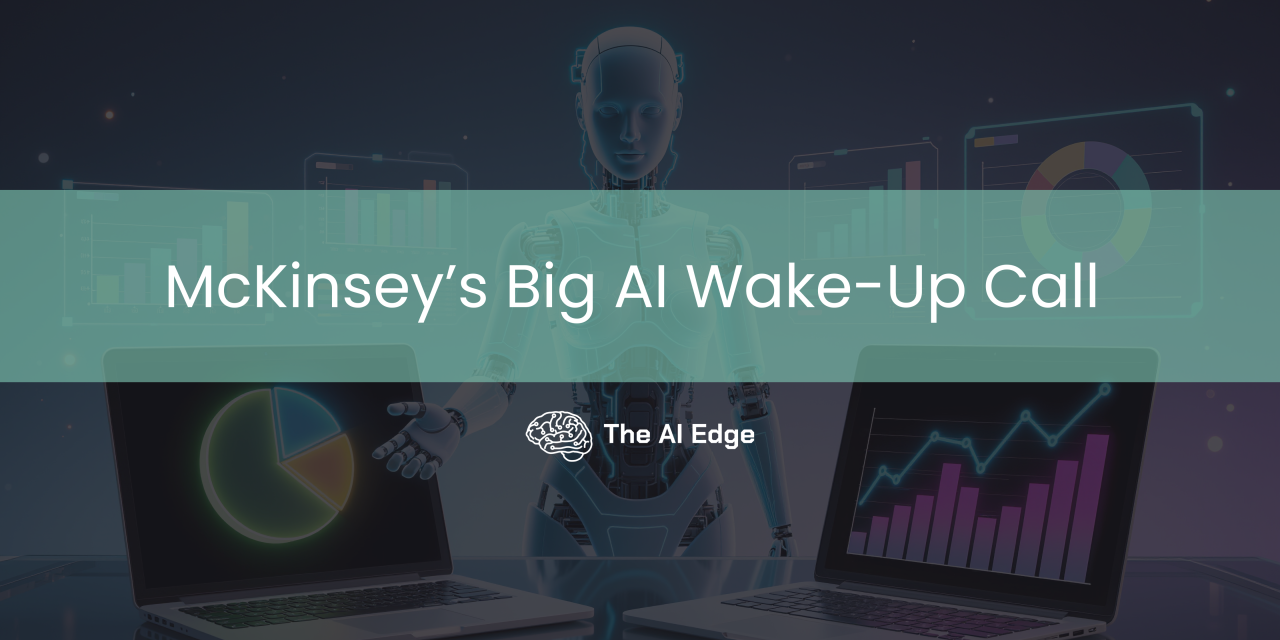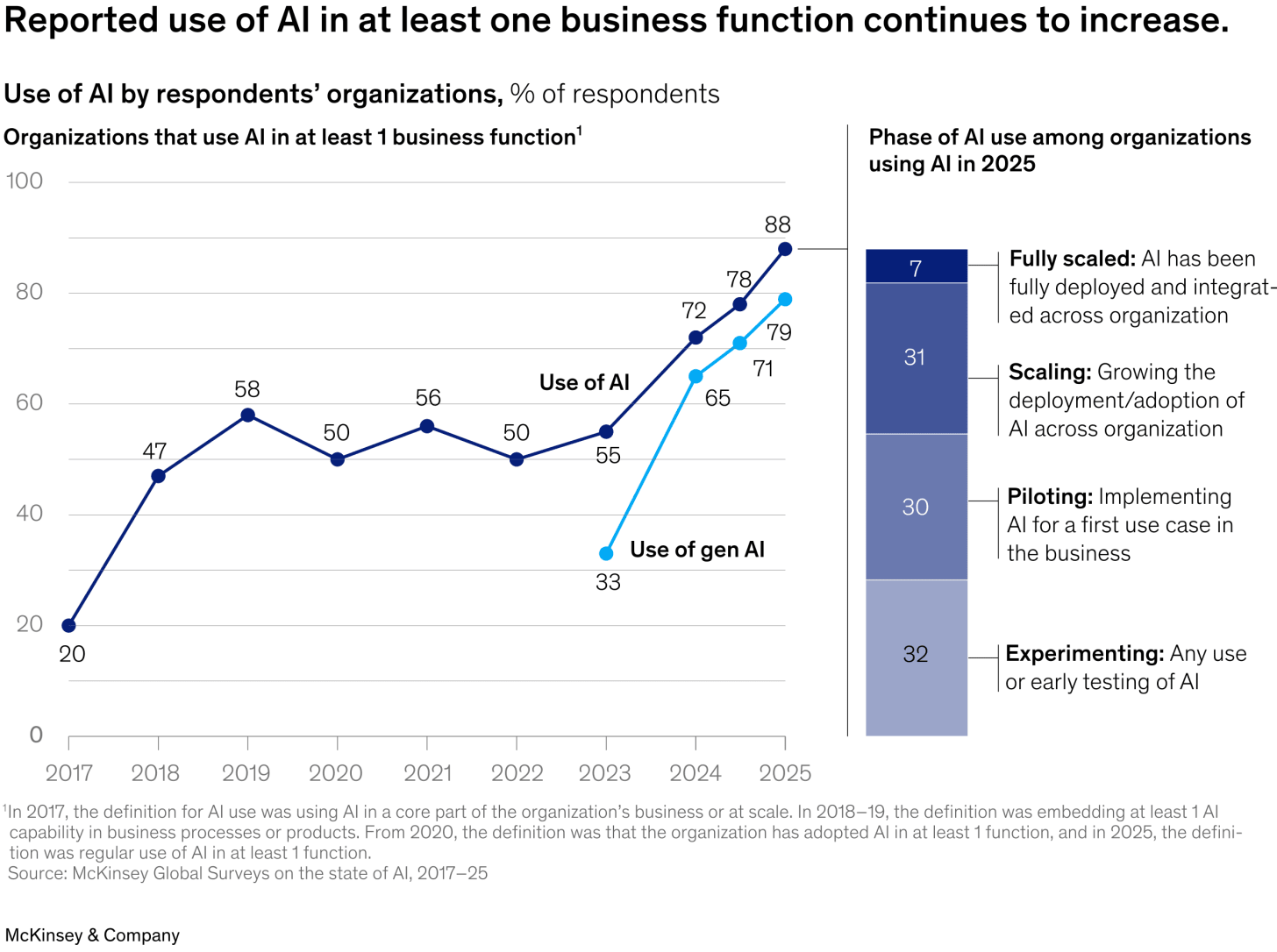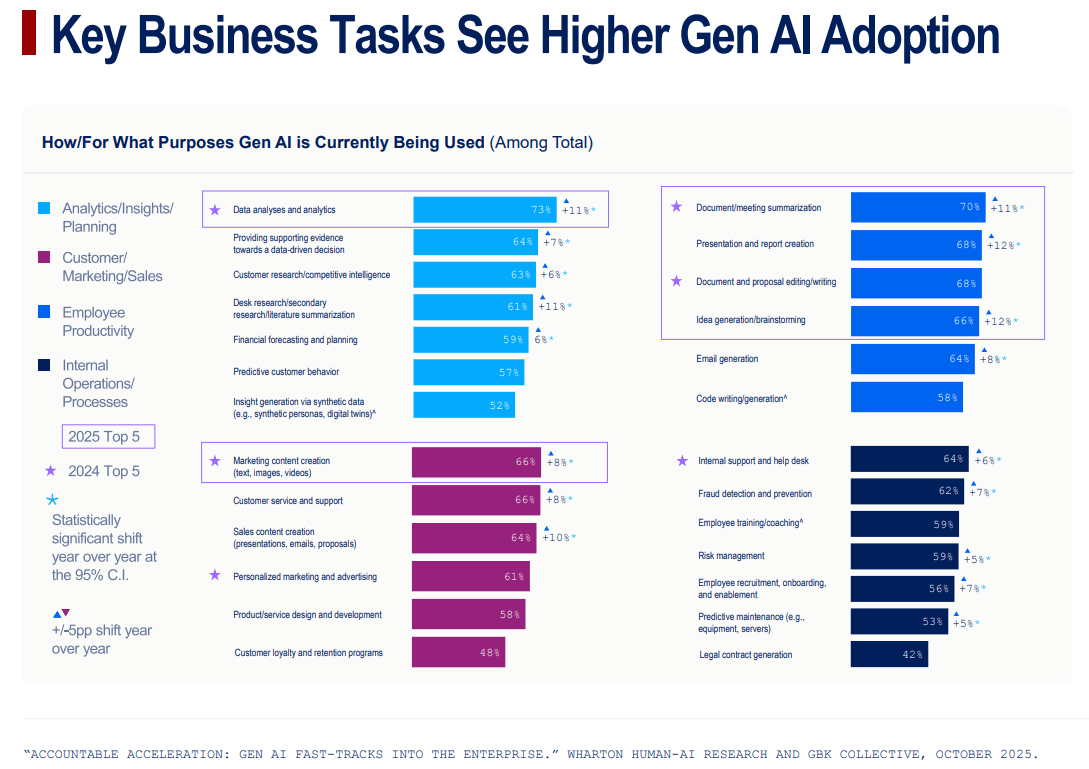Hello Engineering Leaders and AI Enthusiasts!
This newsletter brings you the latest AI updates in just 4 minutes! Dive in for a quick summary of everything important that happened in AI over the last week.
And a huge shoutout to our amazing readers. We appreciate you😊
In today’s edition:
🤖 McKinsey report reveals AI’s reality check
💼 Wharton finds C-suites betting big on AI
🚀 Moonshot AI unveils Kimi K2 Thinking
🧠 Anthropic explores Claude’s introspection
🌐 OpenAI rolls out smarter GPT-5.1
💡 Knowledge Nugget: Peeling the AI Anxiety Onion by Nathan Goldschlag
Let’s go!
McKinsey reveals AI’s reality check
McKinsey’s latest “State of AI 2025” report paints a mixed picture of enterprise AI progress. Out of nearly 2,000 organizations surveyed, 88% said they use AI somewhere in their operations. But only a third have scaled it beyond pilots, and even fewer, just 6%, see significant financial gains of 5% or more.
Meanwhile, 62% of companies are experimenting with AI agents, but only 23% have deployed them at scale, mostly in IT and knowledge management. On the workforce front, one in three organizations expects AI-driven reductions in size next year, while 13% predict headcount growth.
Why does it matter?
This reveals how few companies approach AI with true intent. High performers move beyond automation and use AI to redesign workflows, connect business functions, and innovate at scale. Their results show that meaningful impact comes from reengineering work around AI, not simply adding it to existing systems.
Wharton finds C-suites betting big on AI
Wharton’s latest Enterprise AI Report shows a clear inflection point in adoption. Surveying 800 senior U.S. decision-makers, the study found that AI budgets are growing across nearly every sector, with 88% of companies planning to boost spending next year. Business leaders now use AI for data analysis, marketing, meeting summaries, and report generation, while tools like ChatGPT and Microsoft Copilot dominate daily workflows.
C-suite ownership of AI strategy jumped 16 points year-over-year, and 60% of enterprises have already appointed a Chief AI Officer. Nearly three-quarters of companies now track AI’s ROI through productivity or profit metrics.
Why does it matter?
The report cuts through the noise around AI fatigue and job fears. Beneath the headlines, companies may be quietly getting real value while optimism across the board suggests enterprise AI might finally be delivering on its long-promised potential.
Moonshot AI unveils Kimi K2 Thinking
Alibaba-backed Moonshot AI has released Kimi K2 Thinking, an open-source reasoning model that rivals GPT-5 and Claude 4.5 Sonnet across several benchmarks, at a fraction of the cost. The model achieved a top score of 44.9% on Humanity’s Last Exam and showed big leaps in coding and creative writing compared to its earlier version launched just four months ago.
Beyond benchmark gains, K2 can autonomously chain together 200–300 tool calls to solve complex tasks, demonstrating progress toward agent-like behavior. The model was reportedly trained for under $5 million, putting its development far below the budgets of frontier systems from OpenAI or Anthropic.
Why does it matter?
Jensen Huang recently claimed China is only “nanoseconds” behind in AI and Kimi K2 seems to prove it. The model pushes Chinese and open-source research closer to frontier performance than ever before, with a training cost low enough to challenge the economic advantage of closed AI giants.
OpenAI rolls out smarter GPT-5.1
OpenAI has launched GPT-5.1 on ChatGPT, introducing two distinct models: Instant and Thinking. GPT-5.1 Instant delivers warmer, more playful conversations, following instructions more naturally and sounding less robotic. GPT-5.1 Thinking focuses on advanced reasoning, adapting its processing time to match query complexity while offering clearer, less jargon-heavy responses.
Alongside these models, users can now customize ChatGPT’s tone and style using personality presets like Friendly, Professional, Quirky, and Nerdy, or add personal instructions to guide the AI. The rollout begins with paid users, with free and logged-out users gaining access later, and legacy GPT-5 models remain available for a limited period.
Why does it matter?
The GPT-5.1 launch feels unusually low-key for OpenAI, with little fanfare or benchmark buzz. It could point to a strategic move to stay ahead of Google’s upcoming Gemini 3 release, or a shift toward faster, quieter update cycles rather than big splashy rollouts.
Anthropic explores Claude’s introspection
Anthropic researchers found that Claude can occasionally detect when concepts are artificially inserted into its internal reasoning, a sign of early, limited introspective capability. In tests where words like “bread” or “loudness” were planted, the model flagged something unusual about 20% of the time.
The study also showed that Claude can separate its own “internal thoughts” from the text it reads. When prompted to “think about” a specific word, it adjusted its internal patterns and could clearly distinguish between the injected thought and the written content. Taken together, the findings suggest a small but measurable ability for models to observe and modulate their own reasoning processes.
Why does it matter?
The study hints at an early step toward transparency in how models “think.” But it also raises a new concern: if models can track their thoughts, they might someday learn to hide or misrepresent them too.
Enjoying the latest AI updates?
Refer your pals to subscribe to our newsletter and get exclusive access to 400+ game-changing AI tools.
When you use the referral link above or the “Share” button on any post, you’ll get the credit for any new subscribers. All you need to do is send the link via text or email or share it on social media with friends.
Knowledge Nugget: Peeling the AI Anxiety Onion
In this article, Nathan Goldschlag unpacks a curious paradox: while 42% of U.S. workers believe AI threatens jobs, only 24% see it as a risk to their own careers. Those who actually use AI, however, are far less anxious, 31% less likely to see it as a threat. Exposure seems to act like “digital therapy,” helping workers recognize AI’s limitations and potential as a complement rather than a competitor.
Interestingly, demographic factors like age, education, or political affiliation barely matter. What does? Belief systems. Workers who feel undervalued, pessimistic about job prospects, or dissatisfied with their careers are significantly more likely to fear AI’s rise.
Why does it matter?
This research reframes AI fear as a matter of psychology, not technology. The more people use AI, the less they dread it, proving that familiarity, not fear, will drive the next phase of AI adoption.
What Else Is Happening❗
🎤 ElevenLabs launches Iconic Voice Marketplace, letting brands license AI-replicated celebrity voices from 28 actors, musicians, and historical figures.
🧩 GPT-5 becomes the first AI to solve a full 9×9 Sudoku puzzle, doubling previous benchmark performance and demonstrating advanced spatial and logical reasoning.
📝 ElevenLabs unveils Scribe v2 Realtime, a transcription model with top accuracy that supports live agent understanding in 90 languages.
🍏 Apple plans a custom 1.2T-parameter Gemini model to overhaul Siri, running on its private cloud and licensing Google tech for about $1B annually.
💍 Sandbar launches Stream Ring, an AI wearable that captures whispered thoughts, transcribes them into notes, and doubles as a music controller, priced from $249.
☀️ Google unveils Project Suncatcher, orbiting solar-powered satellites running AI workloads to cut Earth-based energy use, with trials planned for 2027.
🗺️ Cognition launches Codemaps, an AI tool that visualizes codebases to help engineers quickly understand and navigate complex projects.
☁️ OpenAI inks a seven-year, $38B deal with AWS for Nvidia-powered compute, marking its largest move away from Microsoft’s cloud.
New to the newsletter?
The AI Edge keeps engineering leaders & AI enthusiasts like you on the cutting edge of AI. From machine learning to ChatGPT to generative AI and large language models, we break down the latest AI developments and how you can apply them in your work.
Thanks for reading, and see you next week! 😊
Read More in The AI Edge





